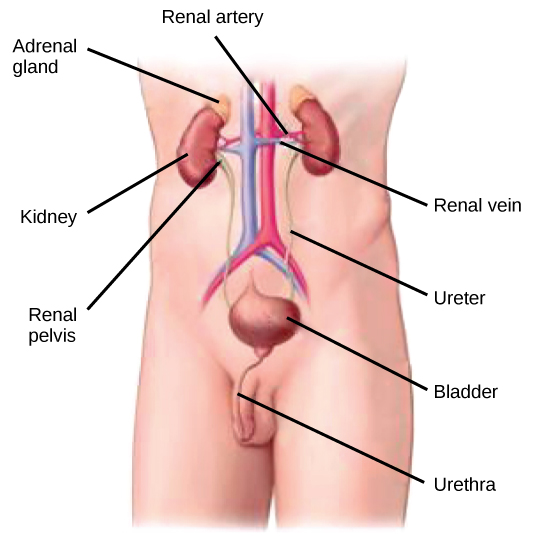| << Chapter < Page | Chapter >> Page > |
The kidneys , illustrated in [link] , are a pair of bean-shaped structures that are located just below and behind the liver in the abdominal cavity. The adrenal glands sit on top of each kidney and function as a component of the endocrine system. Kidneys filter blood and purify it. All the blood in the human body is filtered many times a day by the kidneys; these organs use up almost 25 percent of the oxygen absorbed through the lungs to perform this function. Oxygen allows the kidney cells to efficiently manufacture chemical energy in the form of ATP through aerobic respiration. The filtrate coming out of the kidneys is called urine . Urine is carried from the kidneys to the urinary bladder via the ureters , which are approximately 30 cm long. As urine passes through the ureters, it does not passively drain into the bladder but rather is propelled by waves of peristalsis (smooth muscle contractions). The bladder collects urine from both ureters . During late pregnancy, its capacity (typically several hundred milliliters) is reduced due to compression by the enlarging uterus, resulting in increased frequency of urination. The urethra transports urine from the bladder to the outside of the body for disposal. The urethra is the only urologic organ that shows any significant anatomic difference between males and females; all other urine transport structures are identical. In females, the urethra is relatively short length, about 4 cm, and is less of a barrier to fecal bacteria than the longer male urethra (approximately 20 cm). This length difference is the best explanation for the greater incidence of urinary tract infections (UTIs) in women. The urethra in males also has a reproductive function, as it transports semen (sperm and accessory fluids).

Internally, the kidney has three regions—an outer cortex , a medulla in the middle, and the renal pelvis in the region called the hilum of the kidney. The hilum is the concave part of the bean-shape where blood vessels and nerves enter and exit the kidney; it is also the point of exit for the ureters. The renal cortex is granular due to the presence of renal corpuscles; nephron tubules can be found throughout the renal cortex and renal pyramids , the multiple tissue masses that make up the majority of the renal medulla. There are, on average, eight renal pyramids in each kidney. Urine that is produced by the nephrons travels into the renal pelvis and then into the ureters, which carry the urine to the bladder.

Notification Switch
Would you like to follow the 'Human biology' conversation and receive update notifications?